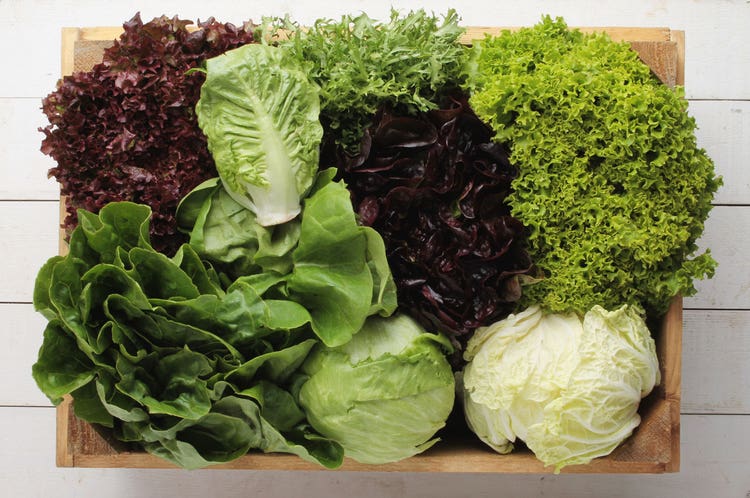From Greens To Greatness

Crafting a salad may seem fairly uncomplicated — a bowl of greens, a handful of toppings, a drizzle of dressing, a fresh grind of pepper. But crafting a nutritional powerhouse that’s satisfying as well as delicious? There’s a bit more to it. Follow this guide and you’ll be on your way to salad nirvana in no time.
STEP 1: ASK YOURSELF WHEN YOU WILL EAT THE SALAD
Is it a hearty lunch salad, a main course dinner salad, or a smaller side salad? The portion size for each can vary greatly, but more important than the size of the finished salad is what’s inside, says Jackie Newgent, RDN, CDN. She suggests building main dish lunch and dinner salads with at least 300 calories and 0.5 ounces of pure protein, which is equivalent to about 2 ounces of chicken breast or 1 cup of kidney beans. “If it’s less than this, consider it a side salad,” she says.
STEP 2: START WITH AWESOME INGREDIENTS
Synergistic food pairings (where two ingredients work together for maximum health benefits) can also help boost the nutritional power factor. Try pairing onions with grapes for a quercitin and catechin combo that may boost heart health and inhibit a certain type of breast cancer cell; or tomatoes with broccoli for an antioxidant and phytochemical pairing that showed powerful anti-cancer action in a University of Illinois study; or couple Vitamin C-rich lemon with spinach to make that leafy green’s iron more bioavailable.
STEP 3: SKIP SNEAKY SALAD EXTRAS
Don’t be fooled into thinking the bags of croutons and sugary dried fruit placed strategically near the lettuce in the produce section are healthy. In fact, loading up on these kinds of toppers is one of the quickest ways to the kind of nutritionally lacking calorie bomb salad you find in many restaurants.
STEP 4: BE CHOOSY ABOUT YOUR CHEESE
Not every salad needs cheese to taste good. Now that we’ve gotten that out of the way, if you love it, there’s no reason why you shouldn’t put it on your salad every now and then. With its creamy texture and rich flavor, a little goes a long way (loading up on cheese = calorie bomb warning). Stick to goat, which packs more protein for fewer calories, or something strongly flavored like blue cheese so you get more bang for your calories.
STEP 5: MASTER THESE LOW-CALORIE FLAVOR TRICKS
There are a number of great techniques, such as toasting nuts and seeds and finishing with freshly ground black pepper. Herbs and citrus zest are also great flavor boosters: “Toss salad greens with a favorite fresh herb, like whole mint leaves; it’s so refreshing and provides an herbal flair and fragrance,” says Newgent, or “grate lemon, lime, or orange peel into your salad for a burst of citrus.” Sharon Richter, RD enjoys experimenting with bold-flavored vinegars, such as champagne vinegar or a fig balsamic. Fresh fruit like berries, sliced apple or pear, or really anything you like that’s in season adds a pop of sweetness for far fewer calories than the dried stuff (especially compared to the sugary kind)
STEP 6: THINK SNAP, CRACKLE, CRUNCH
Salads are more enjoyable and satisfying when there are a variety of textures in every bite. Instead of those fried croutons, add crunch with plain chopped nuts (healthy dose of hunger-fighting fat) or crumbled whole grain crackers.
STEP 7: MAKE YOUR OWN DRESSING
Another quick way to an unhealthy calorie bomb salad? Piling on store-bought dressings, which are often loaded with fat, salt, sugar and other additives. Homemade vinaigrettes are key. And They. Are. So. Easy. “Keep it simple,” Newgent says: “just whisk together equal parts acid (vinegar or lemon or lime juice) and extra-virgin olive oil.” Try grapeseed oil instead of olive for a mild-tasting vinaigrette.
STEP 8: PUMP UP THE STAYING POWER HEALTHY TOPPINGS
Grains: these are a great way to add fiber and heartiness to a salad – think farro, freekeh, quinoa and bulgur. Cooking the grains in bulk in advance makes it easy to add them to salads throughout the week.
- Power proteins: Newgent suggests eggs, beans, chickpeas, lentils and organic edamame. Meat-eaters should stick to chicken, low-mercury tuna and salmon.
- Healthy fats: Adding some fat to your salad helps you feel more satisfied and keeps you feeling full longer. Try avocado or nuts and seeds, such as pistachios or hemp seeds, recommends Newgent, just be sure to keep the portion size small so you don’t go overboard on calories.
STEP 9: MAKE IT PORTABLE
Stacking lunch salads in Mason jars is an easy way to do this: add dressing to the bottom and leafy greens at the top. This smart stacking technique will keep the salad from getting soggy.
MORE SALAD INSPIRATION
Because a great salad isn’t so great if you’re bored.
- Use salad to make delicious use of leftovers, like an Asian salad with leftover Chinese takeout. This also applies to the crumbly bits at the bottom of your cracker or cereal box or bag of pretzels.
- Salads also don’t have to be reserved for dinner. Top with a couple of poached or pan-fried eggs and serve for breakfast. A Bloody Mary can even be transformed into a tasty vinaigrette – just shake together with a little oil.
- Switching between sweet and savory flavors is also a great way to mix it up. One day do grilled chicken and almonds with a little barbeque sauce mixed into your simple vinaigrette, and then the next sweeten up your chicken with a blend of mango, avocado and raspberries with sunflower seeds. Make it more Italian with sun-dried tomatoes, artichoke hearts and pine nuts, or go Mexican with beans, salsa and raw corn for crunch.